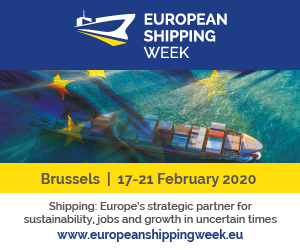

21 February 2020
Decarbonisation measures being implemented by the European maritime sector were seen first-hand today by EU and national policymakers who visited the Port of Antwerp as part of this week’s European Shipping Week activities.
The full-day visit started with a guided tour of the impressive Port Authority Building designed by Iraqi-British architect Zaha Hadid, opened recently in 2016. The design is said to symbolise the “dynamic, reliable, ambitious and innovative nature” of the port.
Representatives from the European Commission, the European Parliament and the permanent representations of Member States were shown the various efforts being made by the maritime community to meet the IMO’s ambition to at least halve GHG emissions from international shipping by 2050.
Such efforts include shore-side electricity and the development of alternative fuels such as hydrogen and LNG. Recently it was announced that the Port of Antwerp will be home to the first tug powered by hydrogen. This ultra-low-emission tug is being built by Compagnie Maritime Belge (CMB), a pioneer in the field of hydrogen power for shipping. With this world’s first, Antwerp is making an important step in the transition to a sustainable, CO2-neutral port.
“Ports can make a significant contribution in the energy transition,” said Jacques Vandermeiren, CEO of the Port of Antwerp. “As Europe’s largest integrated maritime chemical cluster and as a community builder, we commit ourselves to be a pioneer in port decarbonisation.
“Apart from our active participation in the Climate Action Programme with other major ports and the UN ‘Getting to Zero’ Coalition, we are working towards becoming a CO2-neutral port. Together with our partners we prepare for a low-carbon future. We are in a constant search for innovative applications and opportunities. This visit from the EU policymakers offers us an opportunity to show them, by means of concrete projects, which progress we are making.”
The visitors were also treated to a scenic view of the port at Point Lillo and an experience of the simulators at Brabo’s maritime pilots’ training centre. They also took a ride on the fast boats that are currently used to transport the pilots to the ships.
“Decarbonisation can only happen through the combined efforts of the whole maritime cluster,” said ECSA Secretary General, Martin Dorsman. “By working with the ports, such as the Port of Antwerp, and other maritime partners, the shipping industry and indeed the whole maritime sector can only benefit from the global regulation at the IMO, supported by the EU. It is the only way to make real progress and ensure level playing field for our businesses.”
For more information, please contact: Harold Tor-Daenens, Harold.Tor@ecsa.eu
